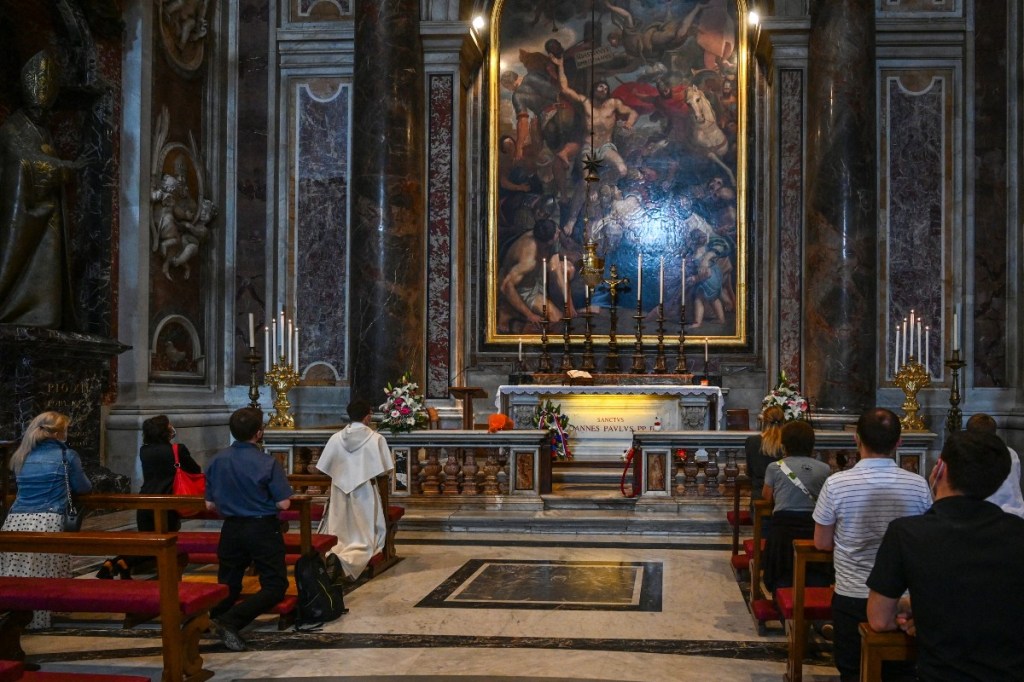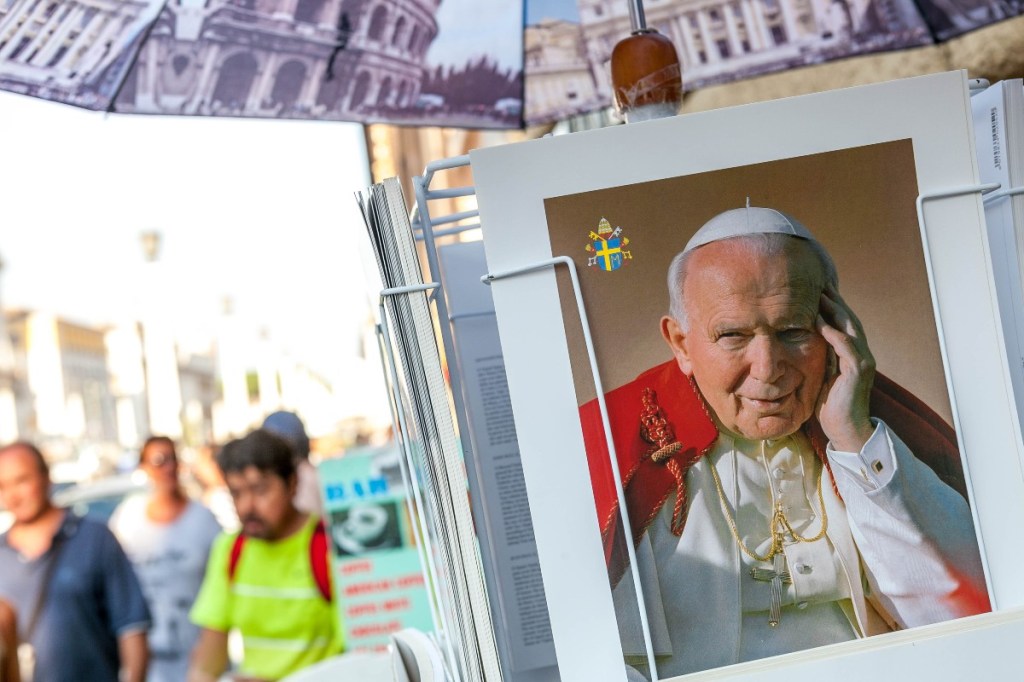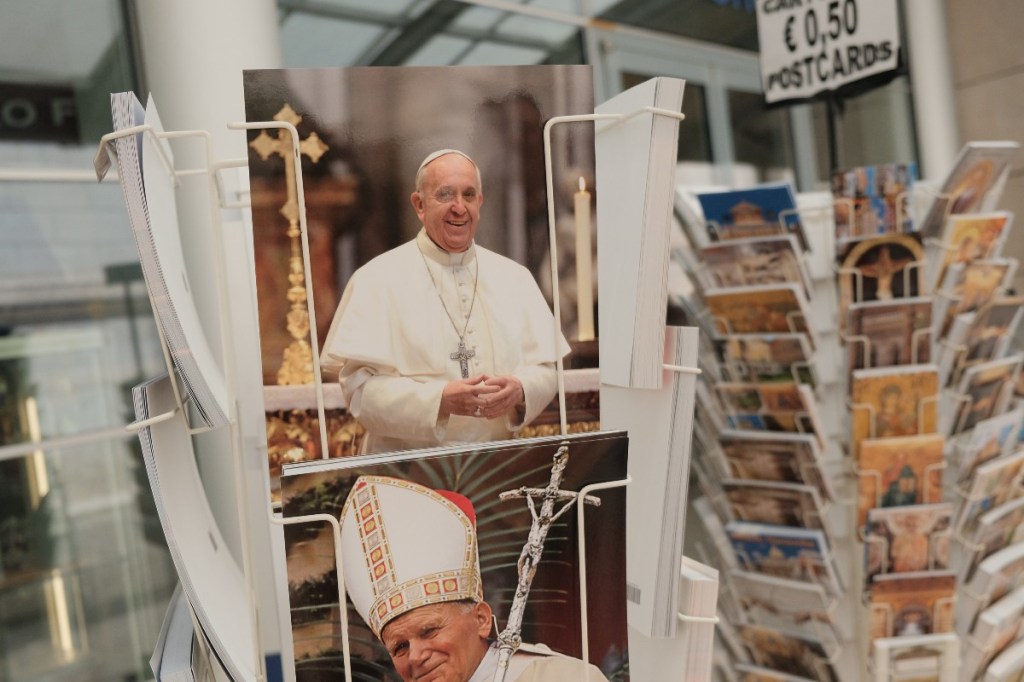Saturday, April 27, marks ten years since the canonization of John Paul II, elevated to the rank of saint by Pope Francis at the same time as John XXIII. However, the Polish pontiff’s canonization was celebrated with less pomp than his beatification on May 1, 2011. What remains of his legacy in Rome today?
Their number varies from a few dozen to a few hundred depending on the week, but the rite is invariable: every Thursday morning, at exactly 7:10 a.m. – so that it can be broadcast on Vatican Radio – the Poles from the Vatican and those on pilgrimage to Rome They gather to celebrate a Mass at the tomb of John Paul II, “their” Pope, the man who restored dignity to a people crushed by the communist yoke.
“I remember very well the reaction of the people in Poland, in the streets, when they heard about the election of the archbishop of Krakow on October 16, 1978,” says a Pole who now lives in France. “The regime-controlled media reported briefly and there was no mass demonstration of joy, but in the way people stood up and walked down the street, there was a renewed energy and pride. They stood tall. John Paul II had given hope to an entire people. That moment is unforgettable,” he admits.
Placing the legacy of John Paul II in Rome is, therefore, above all, recognizing the red and white flags of the numerous Polish groups, visible every day, and during all the Angelus and general audiences. For millions of Poles of all generations, the pilgrimage to Rome is an unavoidable experience, even for people of modest means who save several years to make this journey in the footsteps of their Pope, who reigned for more than a quarter of a century.
The Thursday morning Mass at the tomb of John Paul II is usually celebrated by Cardinal Konrad Krajewski, current Prefect of the Dicastery for the Service of Charity. He intimately served the Polish Pontiff as a papal ceremonial celebrant during the final years of his life, when his illness required great delicacy and ingenuity in donning liturgical vestments and physically supporting him during celebrations. Monsignor Krajewski’s attentive and concerned gaze can still be seen in many photos from that time.
But this attachment extends beyond Polish citizens and sometimes reaches more unexpected profiles, such as that of the young priest from Benin that we met at Mass on Thursday morning and who, without having ever set foot in Poland, took the initiative to learn the Polish language out of passion for this mystical and intellectual Pope whose thoughts he wanted to capture in his original text.

Vincenzo PINTO / AFP
For pilgrims from Italy, France and the United States, the tomb of John Paul II is also an essential part of their visit to the Vatican. It is not uncommon to hear children born long after 2005, and who therefore did not know him, ask their parents about this figure whose importance they perceive when observing the number of people who pray at his grave.
John Paul II remained popular in the hearts of Romans
Around the Vatican and in the city of Rome, the face of John Paul II continues to appear in many souvenir shops, religious communities and parishes. Stefano Cascio, the dynamic parish priest of Saint Bonaventure, in a difficult peripheral neighborhood of the Italian capital, proudly shows photos of John Paul II coming to bless the church under construction in the late 1970s, when the communist municipality of Rome threatened to prevent its construction: a story that echoed his own struggles as archbishop of Krakow.
“As long as his health permitted, he was very attached to his role as bishop of Rome, visiting almost all the parishes of his diocese,” recalls Don Stefano, who admired his physical and spiritual courage and entered the seminary under his pontificate, before after being ordained a priest by Benedict XVI in 2008.

Shutterstock
For some Romans more disconnected from the Church, however, the succession of three non-Italian popes remains a difficult reality to assimilate, as demonstrated by this scene recently observed in a restaurant near the Vatican. Pointing to the contemporary pope paintings on the restaurant’s walls, an elegant woman said: “Quello è il Polacco, e quello il Tedesco” – “That’s the Polish one, and that’s the German one.” This way of referring to John Paul II and Benedict XVI by their nationality is relatively common in Rome, and shows how difficult it is for the inhabitants of the Eternal City to “adopt” a Pope from another place, despite the fact that this reality forms part of the life of the local Church for more than 45 years.
Pope Francis: rupture or continuity?

Shutterstock
Coming from Argentina, with an often disconcerting and provocative way of expressing himself, Pope Francis has sometimes shocked Polish visitors by appearing to be upset by a form of personality cult around John Paul II. His brief homily at the April 2014 canonization disappointed many pilgrims. On a more academic and intellectual level, the change of leadership at the head of the John Paul II Institute for the Family, organized for the summer of 2019, appeared to some as a way of shelving the legacy of the Polish pontiff.
This interpretation is rejected by the current president of this institution, now renamed “Pontifical John Paul II Theological Institute for the Sciences of Marriage and Family.” Interviewed by I.MEDIA in 2023, Monsignor Philippe Bordeyne explained that “what we use today to think about marriage and family is both a personal and conjugal ethic, and a social ethic. Doctrine is all this. But it goes hand in hand with a detailed understanding of today’s difficulties and opportunities.” This work corresponds to the wish of Pope Francis for the John Paul II Institute: I try to assume the breadth of current changes, and draw resources from doctrinal tradition, but also from philosophy and the human sciences, to show that the relevance of the Gospel It’s still amazing.”
From this point of view, it would be a disservice to the personalist philosophy of John Paul II to consider it “fixist”, without updating its intellectual heritage to take into account current challenges. On the other hand, others are concerned about the appearance of a certain relativism in the Church, especially in matters related to morality and sexuality.
Certain proposals of the German Synod have caused consternation within the Polish Catholic Church, as have certain statements by Pope Francis on the war in Ukraine, a sensitive issue in which his position towards Russia is perceived as too accommodating. Furthermore, the doctrinal declaration Fiducia supplicans, which opens the way to non-liturgical blessings for same-sex couples, has given rise to strong misunderstandings, as some see it as a break with the marital ethics promoted by John Paul II.
This debate on the legacy of the Polish pontiff will be resumed in April 2025, on the 20th anniversary of the death of John Paul II.
Within the framework of the Jubilee, this commemoration will undoubtedly be the occasion for his most senior collaborators and the Pope to pay him a heartfelt tribute, after the numerous media attacks on his handling of abuse cases, which have weakened the perception of his pontificate. , and some have even questioned his canonization.
infinite worthy
Has the time come to rehabilitate John Paul II? The recent document Dignitas infinite mentions it twelve times. And in the general audience last Wednesday, Francis paid tribute to the memory of the man who made him a cardinal in 2001.
“Looking at his life, we can see what man can achieve by welcoming and developing in himself the gifts of God: faith, hope and charity,” said the pontiff, asking everyone to remain “faithful to his legacy” and Therefore, “promote life and do not be fooled by the culture of death.”
The promotion of the “civilization of love” against all forms of polarization and selfishness therefore remains a topical issue and a living legacy of the Polish pontiff.
